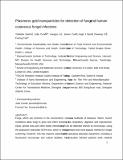| dc.contributor.author | Sojinrin, Tobiloba | |
| dc.contributor.author | Liu, Kangze | |
| dc.contributor.author | Curtin, James | |
| dc.contributor.author | Byrne, Hugh J | |
| dc.contributor.author | Cui, Daxiang | |
| dc.contributor.author | Tian, Furong | |
| dc.contributor.author | Byrne, Hugh J. | |
| dc.contributor.author | Osorio De Castro Conde, Joao | |
| dc.date.accessioned | 2017-07-10T15:24:04Z | |
| dc.date.available | 2018-04-01T05:00:06Z | |
| dc.date.issued | 2017-06 | |
| dc.date.submitted | 2017-03 | |
| dc.identifier.issn | 1618-2642 | |
| dc.identifier.issn | 1618-2650 | |
| dc.identifier.uri | http://hdl.handle.net/1721.1/110585 | |
| dc.description.abstract | Abstract
Fungi, which are common in the environment, can cause a multitude of diseases. Warm, humid conditions allow fungi to grow and infect humans via the respiratory, digestive and reproductive tracts, genital area and other bodily interfaces. Fungi can be detected directly by microscopy, using the potassium hydroxide test, which is the gold standard and most popular method for fungal screening. However, this test requires trained personnel operating specialist equipment, including a fluorescent microscope and culture facilities. As most acutely infected patients seek medical attention within the first few days of symptoms, the optimal diagnostic test would be rapid and self-diagnostic simplifying and improving the therapeutic outcome. In suspensions of gold nanoparticles, Aspergillus niger can cause a colour change from red to blue within 2 min, as a result of changes in nanoparticle shape. A similar colour change was observed in the supernatant of samples of human toenails dispersed in water. Scanning electron microscopy, UV/Vis and Raman spectroscopy were employed to monitor the changes in morphology and surface plasmon resonance of the nanoparticles. The correlation of colour change with the fungal infection was analysed using the absorbance ratio at 520 nm/620 nm. We found a decrease in the ratio when the fungi concentration increased from 1 to 16 CFU/mL, with a detection limit of 10 CFU/mL. The test had an 80% sensitivity and a 95% specificity value for the diagnosis of athlete’s foot in human patients. This plasmonic gold nanoparticle-based system for detection of fungal infections measures the change in shape of gold nanoparticles and generates coloured solutions with distinct tonality. Our application has the potential to contribute to self-diagnosis and hygiene control in laboratories/hospitals with fewer resources, just using the naked eye.
Graphical abstract
Colorimetric method for fungi detection with gold nano particles | en_US |
| dc.publisher | Springer-Verlag | en_US |
| dc.relation.isversionof | http://dx.doi.org/10.1007/s00216-017-0414-7 | en_US |
| dc.rights | Article is made available in accordance with the publisher's policy and may be subject to US copyright law. Please refer to the publisher's site for terms of use. | en_US |
| dc.source | Springer Berlin Heidelberg | en_US |
| dc.title | Plasmonic gold nanoparticles for detection of fungi and human cutaneous fungal infections | en_US |
| dc.type | Article | en_US |
| dc.identifier.citation | Sojinrin, Tobiloba; Conde, João; Liu, Kangze; Curtin, James; Byrne, Hugh J.; Cui, Daxiang and Tian, Furong. “Plasmonic Gold Nanoparticles for Detection of Fungi and Human Cutaneous Fungal Infections.” Analytical and Bioanalytical Chemistry 409, 19 (June 2017): 4647–4658 © 2017
Springer-Verlag Berlin Heidelberg | en_US |
| dc.contributor.department | Massachusetts Institute of Technology. Institute for Medical Engineering & Science | en_US |
| dc.contributor.department | Harvard University--MIT Division of Health Sciences and Technology | en_US |
| dc.contributor.mitauthor | Osorio De Castro Conde, Joao | |
| dc.relation.journal | Analytical and Bioanalytical Chemistry | en_US |
| dc.eprint.version | Author's final manuscript | en_US |
| dc.type.uri | http://purl.org/eprint/type/JournalArticle | en_US |
| eprint.status | http://purl.org/eprint/status/PeerReviewed | en_US |
| dc.date.updated | 2017-07-06T04:10:21Z | |
| dc.language.rfc3066 | en | |
| dc.rights.holder | Springer-Verlag Berlin Heidelberg | |
| dspace.orderedauthors | Sojinrin, Tobiloba; Conde, João; Liu, Kangze; Curtin, James; Byrne, Hugh J.; Cui, Daxiang; Tian, Furong | en_US |
| dspace.embargo.terms | N | en |
| dc.identifier.orcid | https://orcid.org/0000-0001-8422-6792 | |
| mit.license | PUBLISHER_POLICY | en_US |
